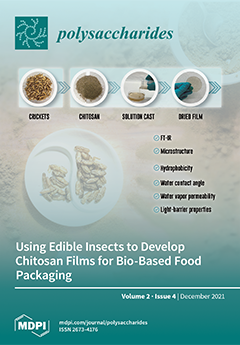Open AccessTechnical Note
Ruminal Lipid A Analysis by Matrix-Assisted Laser Desorption/Ionization Time-of-Flight Mass Spectrometry
by
Efstathios Sarmikasoglou, James R. Vinyard, Mohamed S. Khan, Treenate Jiranantasak, Anay Ravelo, Richard R. Lobo, Peixin Fan, Kwangcheol C. Jeong, Apichai Tuanyok and Antonio Faciola
Cited by 5 | Viewed by 3195
Abstract
Lipopolysaccharides (LPS) are cell wall components from Gram-negative bacteria and are composed of three covalently linked regions: the O-antigen, the core oligosaccharide, and the lipid A moiety, which carries most of their endotoxic activity. The objective of this study was to isolate and
[...] Read more.
Lipopolysaccharides (LPS) are cell wall components from Gram-negative bacteria and are composed of three covalently linked regions: the O-antigen, the core oligosaccharide, and the lipid A moiety, which carries most of their endotoxic activity. The objective of this study was to isolate and compare the lipid A structures from ruminal LPS derived from total mixed ration (TMR)- and pasture-fed cows, by using matrix-assisted laser desorption/ionization time-of-flight mass spectrometry (MALDI-TOF MS). Ruminal bacteria were collected from two rumen-cannulated Holstein cows; one fed a TMR (60:40, forage–concentrate) and the other pasture fed. The representativeness of each sample was validated by comparing the rumen microbiome from the cows in our study to the core rumen microbiome from the previous literature. Lipopolysaccharides from each respective sample were extracted with a phenol–water extraction procedure and purified via ultracentrifugation. To isolate lipid A from the core and O-antigen, pure ruminal LPS samples were hydrolyzed with acetic acid. Lipid A derived from the TMR-fed cow potentially exhibited a tetra-acylated structure, whereas lipid A derived from the pasture-fed cow potentially exhibited a penta-acylated lipid A structure. Both samples were quantified using limulus amebocyte lysate (LAL) assay and exhibited low endotoxic activity, consistent with the MALDI-TOF MS observations. Results indicate that the lipid A acylation pattern differs between diets, and that ruminal bacteria express solely under-acylated lipid A structures contrary to hexa-acylated lipid A, typically expressed by bacteria such as
E. coli.
Full article
►▼
Show Figures





